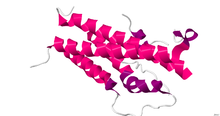| chorionic somatomammotropin hormone 1 (human placental lactogen) | |||||||
|---|---|---|---|---|---|---|---|
 Crystal Structure of human placental lactogen.[1] | |||||||
| Identifiers | |||||||
| Symbol | CSH1 | ||||||
| NCBI gene | 1442 | ||||||
| HGNC | 2440 | ||||||
| OMIM | 150200 | ||||||
| RefSeq | NM_001317 | ||||||
| UniProt | Q6PF11 | ||||||
| Other data | |||||||
| Locus | Chr. 17 q22-q24 | ||||||
| |||||||
| chorionic somatomammotropin hormone 2 | |||||||
|---|---|---|---|---|---|---|---|
| Identifiers | |||||||
| Symbol | CSH2 | ||||||
| NCBI gene | 1443 | ||||||
| HGNC | 2441 | ||||||
| OMIM | 118820 | ||||||
| PDB | 1Z7C | ||||||
| RefSeq | NM_020991 | ||||||
| UniProt | P01243 | ||||||
| Other data | |||||||
| Locus | Chr. 17 q22-q24 | ||||||
| |||||||
Human placental lactogen (hPL), also called human chorionic somatomammotropin (hCS) or human chorionic somatotropin, is a polypeptide placental hormone, the human form of placental lactogen (chorionic somatomammotropin). Its structure and function are similar to those of human growth hormone. It modifies the metabolic state of the mother during pregnancy to facilitate energy supply to the fetus. hPL has anti-insulin properties. hPL is a hormone secreted by the syncytiotrophoblast during pregnancy. Like human growth hormone, hPL is encoded by genes on chromosome 17q22-24. It was identified in 1963.[2]
- ^ PDB: 1Z7C; Walsh ST, Kossiakoff AA (May 2006). "Crystal structure and site 1 binding energetics of human placental lactogen". J. Mol. Biol. 358 (3): 773–84. doi:10.1016/j.jmb.2006.02.038. PMID 16546209.
- ^ Josimovich JB, Atwood BL, Goss DA (October 1963). "Luteotrophic, Immunologic and Electrophoretic Properties of Human Placental Lactogen". Endocrinology. 73 (4): 410–20. doi:10.1210/endo-73-4-410. PMID 14068826.